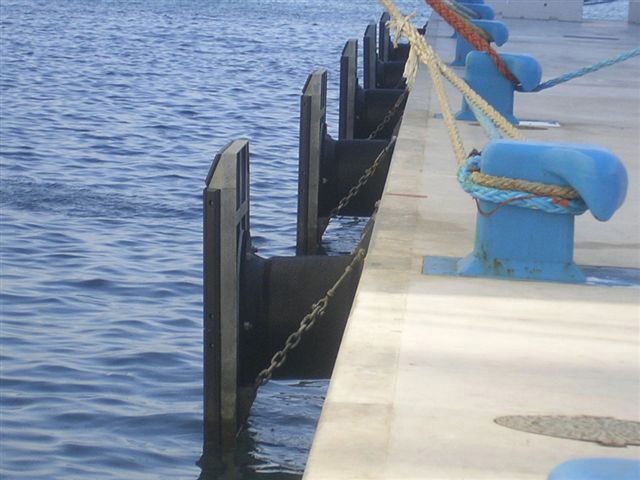We are coming to the end of our series of articles on port equipment for LNG terminals. After looking at the importance of defence systems, we are going to finish by looking at the features of their parts, such as anchors, accessories and shields.
These components need to be manufactured with top-class materials, ensuring the required quality and thickness as well as being installed using approved welding processes.
Anchors
The defence system anchors can be either support or “U” types with variants for new or old concrete. Hot dip galvanised anti-corrosion treatment is recommended.
Hardware
This is primarily used to secure the connection of the elastomer and polyethylene plates to the shield. The hardware should have the same anti-corrosion treatment as the anchors.
Chains
We can classify three different chains according to their operation:
- Traction chains. These are required when the compression on the defence system or the elongation during the system’s angular compression falls outside the acceptable range for the defence body.
- Supporting chains. While these are always recommended, they are not necessary when the add-ons for the defence exceed the maximum that the rubber element can withstand, which can result in the ‘pitching’ of the system. They are also required whenever the vessel is expected to pull the shield down during berthing or while docked.
- Sharp-edged chains. These are required whenever there is a risk of transverse forces that lead to the defence system’s transverse strain limit being exceeded. This limit depends on each manufacturer and each defence type.
Shield
Shields are used for contact with the vessel, ensuring the distribution of the reaction force and coverage of the different tidal movements. These must be therefore designed to withstand the different loads generated.
They are usually distinguished by being open or closed. Closed ones are currently more popular, but require tightness testing and processes to ensure that the hidden parts comply with the materials and thickness calculations. SR275JR or SR355J2 steel is used and in and should secure the weldability in any case. Therefore, the equivalent carbon dioxide must be less than 0.4%.
The part of the shield coming into contact with the hull of the ship is lined with polythene. This is the material of choice for the front of the shield, thanks to its excellent impact, abrasion and wear impact, along with its low friction coefficient. The ultra-high and ultra-high molecular weight polyethylene are generated from a combination of virgin, approximately 30/70% regenerated material. The chemical and mechanical properties of the ultra-high molecular weight polyethylene ensure improved impact-wear resistance, resulting in increased durability.
The shield’s anti-corrosion treatments are another aspect to bear in mind that should be highly durable C5M at the very least, according to ISO 12944-6. Antifouling systems and the in-built sacrificial anodes also reinforce protection against corrosion, therefore there should be contact with water, which performs the role of electrolyte.
Index of published articles
Port equipment for LNG terminals (I)
Port equipment for LNG terminals (II): moving towards a change in regulation
Port equipment for LNG terminals (III): Docking aid systems (I)
Port equipment for LNG terminals (IV): docking aid systems (II)
Port equipment for LNG terminals (V): Berthing-aid systems (III)
Port equipment for LNG terminals (VI): Fender systems (I)
Port equipment for LNG terminals (VII): Defence systems (II)




Comments are closed.